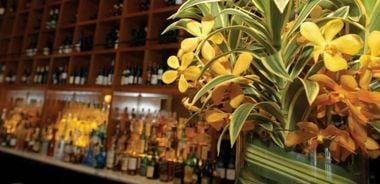Soup of Sunchokes with Roasted Scallops

You might know sunchokes under their more official moniker, Jerusalem artichokes. Since they do not come from Jerusalem and are not artichokes, sunchoke is the more popular market term. Look for them in gourmet grocery stores, and substitute button mushrooms if you can’t find them.
10 sunchokes, peeled
1 small white onion
1 garlic clove
1 celery stalk
1 leek, white part only
1/4 lb (100 g) butter
1 sprig thyme
1 bay leaf
6 cups (1.5 L) vegetable stock
1 1/4 cups (300 mL) milk
1/2 cup (125 mL) heavy cream
12 fresh scallops
4 tsp (20 mL) extra-virgin olive oil
Salt and pepper
Lemon juice, to taste
4 sprigs chervil, as garnish
Coarsely chop all vegetables and herbs. Crush garlic.
Melt butter in large saucepan over low heat and add vegetables, herbs, and garlic. Cook slowly until vegetables begin to soften but not brown, about 10 minutes.
Add vegetable stock, milk, and cream. Bring to boil and simmer until vegetables have completely softened, about 6 minutes. Purée mixture in blender and then pass through a fine sieve. Set aside.
Heat olive oil in a separate saucepan. When oil is very hot, add scallops and cook quickly about 1 minute (depending on size of scallops). Turn and cook other side 1 minute more.
Warm purée soup mixture and season to taste with salt, pepper, and a touch of lemon juice. Divide cooked scallops among four soup bowls and pour soup over. Garnish with chervil. Serves 4.
source: "This February, Go West", alive #380, 2006




